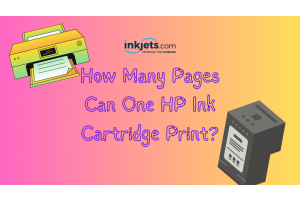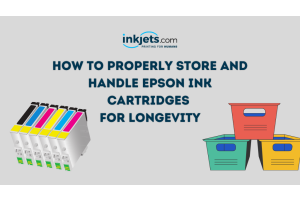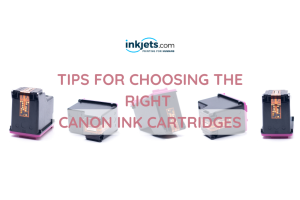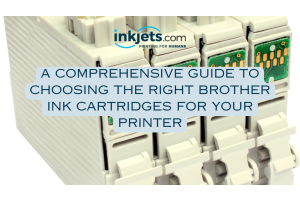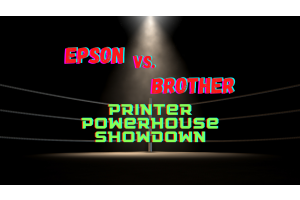
Article last updated April 28, 2023
It’s no secret that the cost of printer ink cartridges is on the rise, yet many consumers don't realize the high volume of ink or toner that their inkjet printer or laser printer uses daily.
If you want to save money and be cost effective in your printing process, it’s important to be aware of how much ink and toner each printed page uses.
When it comes to print supplies, most modern printers have four colors of ink or toner: cyan, magenta, yellow, and black.

The first three are called the "subtractive primary colors", because they can be mixed together to form any other color when printing color prints. Black is, well, black.
And we're going to focus on ways to avoid using so damn much of it.
The more black ink used, the higher your per-page costs will be.
There are a number of ways to reduce the amount of black ink used for printing.
What is printer ink and why does it cost so much?
Most people know that printer ink is a liquid that carries dye or pigment to transfer an image onto paper for printing purposes. What people may not know is that printer ink is also the most expensive liquid an average American household uses on a daily basis.
The average cost per milliliter for OEM (Original Equipment Manufacturer brand, like HP or Canon) liquid ink is $10. If purchasing mouthwash cost that much, you would be paying $200 every time you brush your teeth!
Why are ink cartridges and toner cartridges so expensive?
What makes inks so different to earn their indredibly high cost?
The reason printer ink is so expensive is because it’s a high-tech, high-demand product. Unlike other home appliances that have been around for decades (like clothes washing machines), printers are constantly changing and improving.
In fact, the complicated process for creating the different colors of ink and the technology needed to make it work was only recently perfected in the late 1990s when digital printing took off.
But take off it did.
What's the difference between ink and toner?
Before we go further, let's address an issue that can be confusing to some. The terms ink and toner are sometimes used interchangeably, but that's not technically accurate.
The terms refer to the different types of consumable print supplies that are used in inkjet printers and laser printers.
Toner
Unlike the traditional liquid ink that is used in inkjet cartridges, laser printers use toner cartridges. Laser printer toner cartridges contain toner powder that's made from a polymer resin.

During the process of laser printing, the toner powder is electrically charged so that it will adhere to the page when it's exposed to light.
The toner particles are first given a negative charge in the drum unit and as they pass under the laser beam, they are selectively charged or discharged to create the print image.
The electrical charge is used to adhere the toner particles to the paper, which uses heat so the toner melts and becomes permanently bonded to the paper as it prints.
Ink
Inkjet printers, on the other hand, use tiny nozzles that spray liquid ink onto the pages as they print.
The inkjet cartridges used in these printers contain a reservoir of liquid ink that is forced through those nozzles by a tiny electric pump. The ink is then sprayed onto the paper in microscopic droplets.
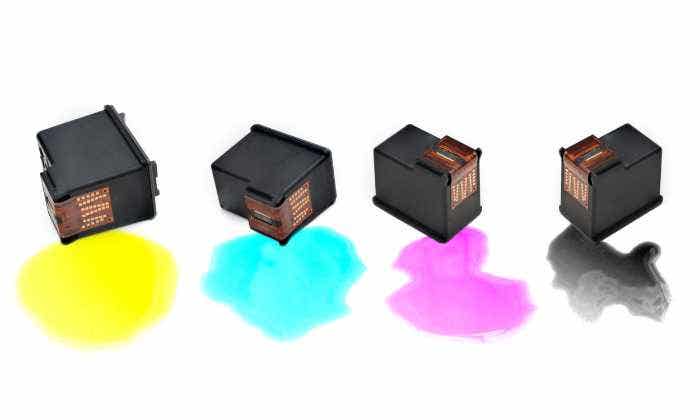
Different colors of ink are contained in separate chambers within the cartridge, with each color being controlled by its own nozzle.
Less (ink) is more.
Today, a lot of people rely on their inkjet printers and laser printers every day for all sorts of printing jobs including photos, letters, bills, cards, and more.
With our growing dependence on using our printers, printing costs can accumulate quickly if not managed well. So it's important to be conscious about how much you’re using your printer and try to reduce the amount of ink used per page as much as possible without sacrificing quality.
Draft mode
Many people aren't aware that their printers have the option to print in different levels of quality. This function is usually called "Draft Mode" or "Reduce/Economy Mode."
When your printer is set to print at its highest quality, the machine uses more of the colors in the ink cartridges (not just black) needed to create the image.
However, when Draft Mode is enabled, the printer uses less of these colors to create a print that still looks good and will not be as heavy on the per-page ink costs. This means you get more pages, or higher page yield, for the same amount of ink
It’s like eating bread with no butter or jam; you can still eat without them and satisfy your hunger; but at a lower quality. Draft lunch, anybody?
Unless your print will be part of an important presentation or document, (or you are unreasonably devoted to peanut butter and jelly) it’s okay to use Draft Mode.
You can even tell your printer to print in Draft Mode all the time if you don’t want to manually change the setting every time you print a document or photo.
Is a picture worth 1000 words?
Avoid using images in your document when possible, as these use an enormous amount of ink. Photos, icons, and graphics will use black ink more than colored text.
It is cheaper to print out a document on plain white paper with no images or graphics. Images can also lower the resolution of your document and make it look pixelated.
In short, keeping your document limited to text whenever possible will save you a lot of money.
A tip we're quite font of.
Using the right font can also save your printer's ink.
Fonts with fewer curves and strokes will use less black ink, so try to stick with fonts with straight lines and solid colors.

It’s best to choose between fonts like Bookman Old Style or Courier New for most documents, as these are standard fonts that are easy to read and use less ink.
Bold elements
Avoid graphics and images with lots of black elements.
If you must include an image in a document that will be printed out, then try using a photo editor to change how much black ink is used before adding it to your document.
If you need to edit a black and white photo, you can do this by changing the number of shades in your image. For example, if you have an image with 20 shades of gray but only want 5 shades, open the photo in a photo editor, click Image -> Adjustments -> Levels, and change the slider until it reaches 5.
The Thin Black Line
If you are using graphs, charts, or spreadsheets, try to use as thin lines as possible.
For example, instead of using a thick black border to separate one bar from another on a graph, use a thin dotted line instead. To edit this in Microsoft Excel you can use the border options to change the style of each line.
Color is the new black
In the world of photography, black and white images are considered to be more artistic than color pictures. However, when you're trying to save money on ink, you shouldn't be thinking strictly in black and white.
Black is obviously the color of ink that gets used the most because it is used for most letters and lines. However, this doesn't mean that printing in black-and-white (or grayscale) would be a good idea when you are trying to save money on printer ink.
To avoid using black ink in graphics or images, there are a few things you can do.
First off, try not to use dark colors in your documents if they will be printing on paper that's white or near-white. This goes for most blacks and navy blues, but it can apply to other colors like dark red and purple as well.
Instead of using images with lots of black or text in a font that uses a lot of black ink, try changing the color to something lighter.
If you're looking to print your document on white paper, change as many things as you can from black or a dark color to lighter shades of grey.
If you are creating a graph or spreadsheet, try using different colors for each section of data rather than using black.
Black ink is not the only color you should avoid using in a document if you’re trying to save money on printer ink. Colors like blue, red, purple, and green can also use a lot of black ink because those colors are made up of many different tones, from light to dark.
It’s best to try and use a color that is either one specific color or uses different tones of the same color in order to save money when printing.
You also want to be careful when using shades of gray in your document because it can be hard for your printer to pick up the exact shade you’re trying to use.

If you are using shades of gray, make the shades lighter instead of darker; this way, your printer can use less ink when printing.
Size matters
You want to be careful about how big the fonts are that you're using, as well as how big your document is printed in terms of size and orientation on paper.
Obviously, smaller fonts and smaller documents mean less ink, which means you'll save money. Most of the time, you will be printing on standard-size paper. But the size of fonts can vary widely.
The best size font to save on ink is 11-12 point, but you can use smaller-sized fonts too. A good rule of thumb is that if you are able to read your document on your screen from a comfortable distance of about 20 inches away, your font is likely a good size to print.
Fonts: Heavy or Light?
The weight of the font you choose also affects ink usage.
As a general rule, you can assume that bolded text uses more ink than normal (non-bold) text.

This is because as words are printed on paper, they must be slightly thicker to give the appearance of being bold. The printer has to add extra ink while printing these words, resulting in a higher cost per page.
Conversely, it's generally better for your ink supply if you use a light font instead of a heavy font.
Buy less expensive printer toner and ink
Another way to save money on your printing is to simply spend less on the ink that you buy.

One of the best alternatives to OEM ink is to buy compatible and remanufactured ink and toner cartridges.
Compatible ink means that it is a brand new ink cartridge that was not manufactured by the same company that made your printer, but it still will fit in your printer and work just fine with it.
Remanufactured cartridges are recycled OEM cartridges that have been taken apart and had the worn parts replaced, then checked for quality to make sure they meet or exceed OEM standards.

Many people prefer these ink and toner cartridges because they offer great value for the money as well as good print quality.
There are a wide selection of compatible and remanufactured cartridges available, though quality can vary. Be sure to purchase your compatible and remanufactured ink from a reliable, trusted vendor.
All inkjet printers and laser printers are welcome!
Inkjets.com is one of the leading online ink stores, and we offer an excellent selection of compatible and remanufactured cartridges for all major brands and printer models. We also pride ourselves on having the best customer service in the business.
If you have any questions about a product before or after purchase, our friendly Customer Experience team members are standing by to assist you.

Recap
So, now you know. One of the best ways to save money on printer ink is by using a combination of the tips mentioned above.
With a little bit of forethought and planning, it’s easy to have a beautiful printout that uses less ink, and therefore less money.
After all, who doesn’t love to save a little money?
Contact Inkjets.com for all your printer ink needs!
Visit us online at https://www.inkjets.com or call 1-888-679-9416 / 1-972-200-3813 Mon - Fri 7 am - 5 pm PST to speak with our friendly customer service representatives.



